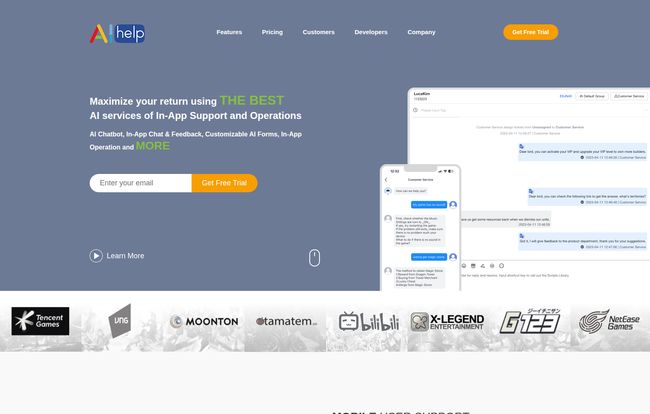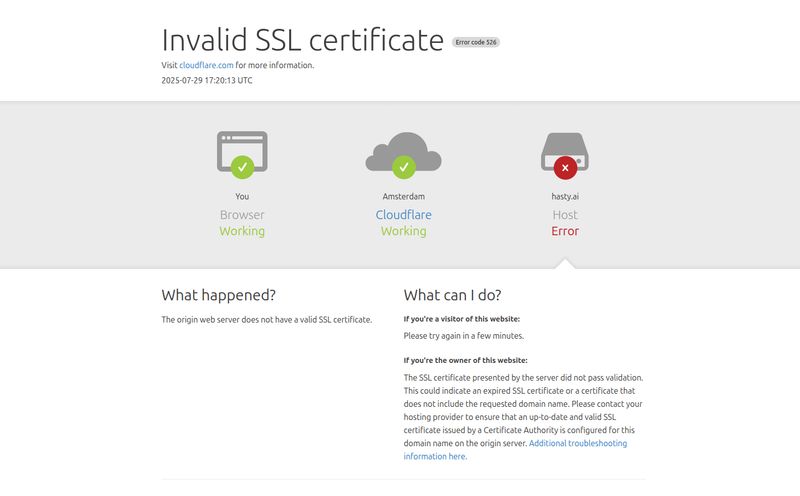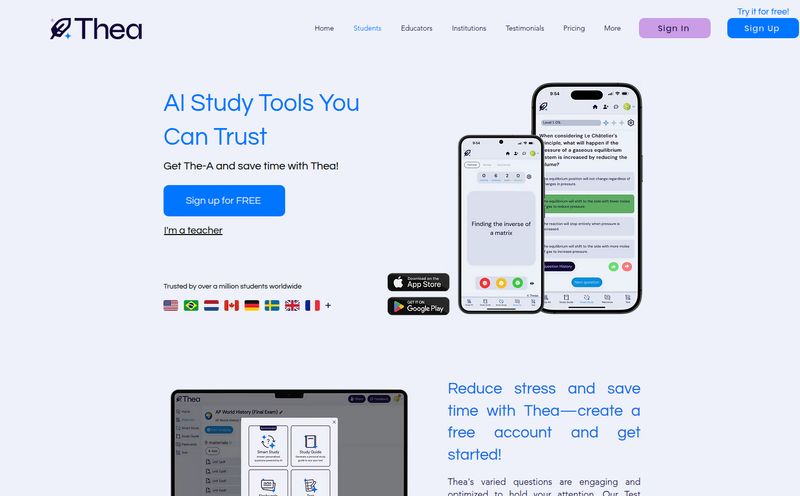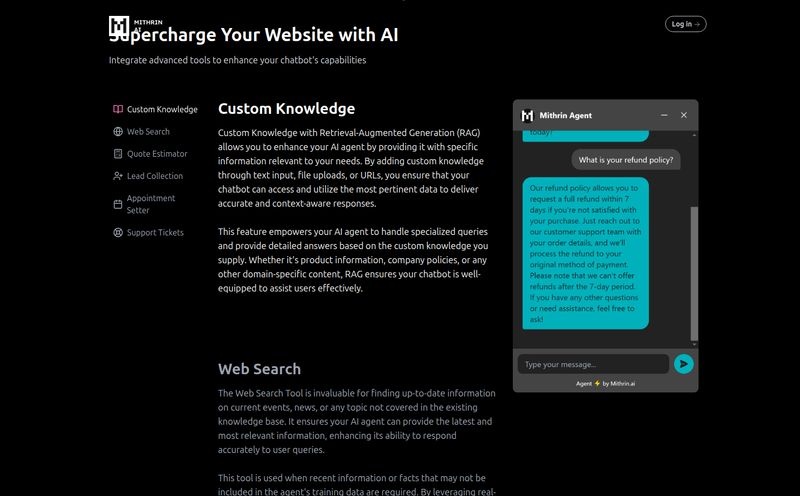In the world of apps and digital products, customer support can feel like a necessary evil. We bolt on a clunky 'Contact Us' form, route it to an already overflowing inbox, and pray for the best. The user experience is often terrible—they have to leave your app, type out their life story, and wait days for a reply. It's a retention killer. I've seen it sink otherwise brilliant apps.
For years, we've been trying to bridge that gap. We want support that feels like part of the product, not an afterthought. And that, my friends, is where I stumbled upon AIHelp. It's been making some noise, especially in the mobile and gaming spheres, with some wild claims about AI-powered support and massive user engagement. So, naturally, I had to see what all the fuss was about.

Visit AIHelp
So, What is AIHelp, Really?
On the surface, AIHelp is an “AI-powered in-app customer support and ticketing system.” But that’s a mouthful of marketing speak. In plain English? It’s a toolkit designed to let you build your entire customer support system directly inside your app or website. Think of it less as a separate department and more as a built-in concierge for your users.
The goal is to stop forcing users to abandon your platform to get help. Instead, they get instant answers from a smart chatbot, or seamlessly create a ticket and chat with a real person, all without ever leaving the screen they're on. It's about meeting them where they are, and honestly, it's about time. The platform boasts some impressive numbers, like supporting over 80,000 apps and handling 800 million+ monthly active users. That's not small potatoes.
The Features That Actually Move the Needle
A platform is only as good as its tools. AIHelp packs a lot in, but a few features really stood out to me as game-changers for anyone serious about user retention and operational efficiency.
The AI Chatbot: Your 24/7 Frontline Agent
This is the star of the show. AIHelp's chatbot isn't just a simple Q&A bot. It's designed for automation. You can train it to handle common queries, guide users through troubleshooting steps, and even collect necessary information before escalating to a human agent. The testimonial from Ahmed Saleh at Team Lao-Egypt-MENA was particularly telling—he claimed that 80% of their customer issues are solved by the chatbot alone. Think about that. That's a massive reduction in agent workload and a huge win for user satisfaction.
Beyond Bots: Smart In-App Chat and Ticketing
When the bot can't solve it, the handoff to a human needs to be smooth. AIHelp’s in-app chat and ticketing system keeps the conversation in one place. It’s not just a chat window; it’s a context-rich environment. Agents can see user data, device info, and chat history, so the user never has to repeat themselves. This context is everything—it’s the difference between a frustrating support experience and a surprisingly delightful one.
In-App Operations and Customization
This is an area where AIHelp seems to pull ahead of some competitors. It’s not just about reactive support. It includes tools for proactive engagement. You can use it to push targeted announcements, run in-app surveys, and collect feedback. It turns your support channel into an operations hub, helping you understand your users better and make smarter product decisions. The customizable AI forms are a nice touch, allowing you to build guided flows for complex issues like bug reports or refund requests.
Let's Talk Money: A Breakdown of AIHelp Pricing
Alright, let's get to the question on everyone's mind: what's this going to cost? AIHelp's pricing is... flexible. Which can be a good or a bad thing depending on your budget's predictability. They offer a mix of per-agent, per-ticket, and usage-based models.
Here’s a simplified rundown of their main tiers:
- Lite (Email Only): At $46 per member/month, this is your basic entry point for email-based ticketing and automation. Good for teams just starting to formalize their support.
- Professional: This tier costs $56 per member/month OR $0.05 per ticket. This flexibility is interesting. It gives you access to the core messaging, help center, and workflow tools. If you have low ticket volume but need more agents, the per-ticket model could be a great deal.
- AI Premium: This is where the magic happens. For $85 per member/month OR $1.80 per 1000 Monthly Active Users (MAU), you unlock the full AI Bot, form automation, push notifications, and more. The MAU pricing is clearly aimed at high-volume B2C apps where per-agent pricing would be astronomical.
- Startup Team: A special plan at $300 semi-annually that gives you all functions. This seems like a fantastic deal for up-and-coming companies to get their feet wet with the full power of the platform.
- Add-Ons: Things like an AI Copilot for agents, CRM integrations, and auto-translation are available, but you'll have to contact them for pricing.
I appreciate that they offer a Free Trial so you can test the waters. The pricing structure shows they understand that a one-size-fits-all approach doesn't work for customer support.
The Good, The Bad, and The SDK Integration
No tool is perfect. After digging in, here's my honest take on the highs and lows.
What I Like
The focus on keeping users in the app is a massive win. It respects the user's time and preserves the flow of their experience. The powerful automation and the impressive 80% resolution stat for the chatbot are hard to ignore. For mobile-first businesses, especially in gaming or SaaS, this could radically optimize support costs and boost customer satisfaction. The flexible pricing is also a plus, offering paths for tiny startups and massive enterprises alike.
What Gives Me Pause
Let's talk about the elephant in the room: implementation. AIHelp is not a simple plug-and-play widget. It requires you to integrate their SDK (Software Development Kit) into your app or website. This means you'll need developer resources. It's not a deal-breaker, but it is a hurdle. It’s like hiring a world-class chef; they can work wonders, but you first need to let them into your kitchen and show them where everything is. Secondly, the effectiveness of the AI is entirely dependent on how well you train and configure it. If you throw it in without proper setup, it won't perform. Finally, the variable pricing, while flexible, could lead to some surprise bills if you have a sudden spike in users or tickets and aren't on the right plan.
Frequently Asked Questions about AIHelp
I had a few questions myself, and these are some of the most common ones people ask.
- What exactly is a Monthly Active User (MAU)?
AIHelp defines it as any unique device that has been active on your app in a given month. It's a pretty standard metric for mobile apps. - Do I need a credit card for the free trial?
Nope. They state on their site that you can start a trial for 21 days without providing credit card details, which is always a good sign in my book. - Is it hard to change plans?
They say you can upgrade your plan at any time. So if your needs change, you’re not locked in, which provides good scalability. - Do they charge extra for supporting both web and mobile?
No, which is great. If you have an app on both iOS and Android, for instance, they don't double-charge you. The MAU is based on the total number of unique users across all platforms you support. - What payment methods do they accept?
You can pay with major credit cards like Visa, Mastercard, or American Express. For larger enterprise plans, I'd wager they offer other arrangements.
My Final Verdict: Is AIHelp Worth It?
So, what's the bottom line? I think AIHelp is a seriously powerful platform for a specific type of business. If you are a mobile-first company, a game developer, or a SaaS provider with a large user base, this tool could be transformative. The ability to automate a huge chunk of your support tickets while improving the user experience is a potent combination.
It's not for the company looking for a quick, cheap fix. It requires a bit of technical lift to get started and a commitment to configuring the AI properly. But for those willing to make that investment, the return—in saved man-hours, higher retention, and happier customers—could be massive. It truly feels like a step toward the future of customer support: integrated, intelligent, and instantly available.



